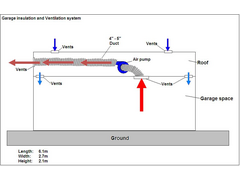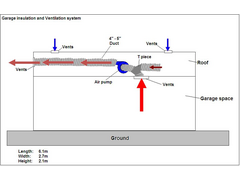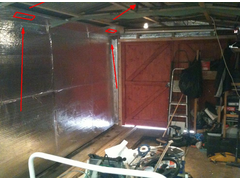b14wrc
|
 posted on 23/6/11 at 11:25 AM posted on 23/6/11 at 11:25 AM |

|
|
Extraction system design
Hi all,
As some of you know i am currently converting my garage into a decent workshop, i have been advised good ventilation is going to be important to stop
it being damp, and considering i have sealed the whole thing up - i am going to fit some form of extraction system. Could you have a quick look at my
drawings and let me know if either of these would be ok, and if not, why and what i could do to improve.
The air pump i have is from an old industrial vent system, not sure of the metres cubed per hour, but expect it to be 3 or four times greater than a
decent shower inline pump rated at about 150m3/hour. It blows out a load of air!
Option 1.
 
Description
Option 2.
 
Description
I was thinking for welding forced venting the garage space to outside would be a benefit any way.
Cheers, Rob
20vt powered rear engined locost
|
|
|
|
|
loggyboy
|
| posted on 23/6/11 at 11:32 AM |

|
|
2nd option would lead to a fair amount of negative pressure build up if the garage is well sealed. DOubt it would extract much from the garage, only
the roof space.
[Edited on 23/6/11 by loggyboy]
|
|
|
dhutch
|
| posted on 23/6/11 at 11:39 AM |

|
|
Any plans for any low-leval vents? Will there be any gas in the workshop (if so what).
|
|
|
b14wrc
|
| posted on 23/6/11 at 11:40 AM |

|
|
Thanks Loggyboy.
So you suggest the first option?
I am more keen on that myself, just want to make sure there is a good flow of air in the roof space to expel unwanted moisture.
I know people may think this is over the top, but i like only doing things once, and the money i have already invested would be wasted if i did not
fit a decent extractor.
Hose size wise, 4" or 5"?
Any one done this?
Rob
20vt powered rear engined locost
|
|
|
b14wrc
|
| posted on 23/6/11 at 11:42 AM |

|
|
There is a vent either side of the main door, this cavity would draw air from the floor into the roof space.
If i am working with fumes, the doors could also be opened.  Just if its winter i may prefer to keep them closed. Just if its winter i may prefer to keep them closed.
20vt powered rear engined locost
|
|
|
britishtrident
|
| posted on 23/6/11 at 11:43 AM |

|
|
A couple of air inlet vents near floor level, air outlet at head height or above and you will get natural convection, then you can add a small
extraction fan.
[I] “ What use our work, Bennet, if we cannot care for those we love? .”
― From BBC TV/Amazon's Ripper Street.
[/I]
|
|
|
mgmiller
|
| posted on 23/6/11 at 12:01 PM |

|
|
Why don't you use the fan to pump air into the garage and then let the positive pressure push the air out thru' your vents?
All the HVAC systems that I can remember have worked that way. Although that is not that many. :-)
|
|
|
HowardB
|
| posted on 23/6/11 at 12:40 PM |

|
|
measuring the number of changes oer hour is an issue, in the winter it will pull in that much fresh (read cold &damp) air every hour. Easiest way
to measure this is with a big dustbin bag, tape round the neck of the outlet, fire up the fan and measure how long it take to fill. Calculate the
volume, and then you'll have a meters cubed oer hour,... divide this by the garage volume and you'll have changes per hour.
If this number is high, it will be impossible to keep warm in winter, I have gone the other route and have a cheap (2nd hand) de-humidifier running on
economy 7. Seems to work ok.
hth
Howard
Howard
Fisher Fury was 2000 Zetec - now a 1600 (it Lives again  and goes zoom) and goes zoom)
|
|
|
coyoteboy
|
| posted on 23/6/11 at 01:41 PM |

|
|
Interesting post. I've a concrete garage (panels and concrete corrugated roof) that should have a damp problem just from being poorly sealed,
but seems generally OK. The problem I have is that if I seal it everywhere I can I'll end up with more of a damp problem due to lack of
ventilation. Seems a bit daft to then pay to ventilate it again, but it is bloody freezing in winter.
|
|
|
loggyboy
|
| posted on 23/6/11 at 01:43 PM |

|
|
quote:
Originally posted by mgmiller
Why don't you use the fan to pump air into the garage and then let the positive pressure push the air out thru' your vents?
All the HVAC systems that I can remember have worked that way. Although that is not that many. :-)
Without being filtered would suck in a whole host of crap!
|
|
|
b14wrc
|
| posted on 23/6/11 at 03:59 PM |

|
|
Thanks for the comments guys…..
Left me a little bit confused on which way to go now though.
Yes, the main reason for the insulation is to get better warmth in the winter, as it was, there was no way I would want to work in there in the
winter, just far to cold! This was writing off any practical work I would want to do for around 4 months of the year – coming home after work on a
dark cold night would not infuse me to get on with re wiring that engine loom I accidently cut through when dismantling the donor car….
So with the batterns put in the right places, fitted the thermally efficient polystyrene, I then went for a foil finish, this is already working as I
intended. On a hot sunny day last week at about 5.30 when I got home from work, the garage would ‘normally’ be red hot, the wall to touch would be
boiling, but the foil was reflecting it back out and the temperature was fairly pleasant. I expect in the winter when I have been in there with a
heater the heat will be reflected back inside.
Filter would be a good adition too!
Moisture, that’s the worry many have raised, last winter, I did not really have a problem, but if the foil now seals up all drafts, am I going to have
a problem?
Reading what people have said, I realise damp may be an issue, extracting it out is a positive, but drawing in excess amounts of cold damp air is a
negative… I can calculate the pump rate – what sort of m3/second would be good?
Would I be better off just putting vents in the roof section and not bother with a air pump?
See photo:
 
Description
Letting thermal convection do the work and hope that the gaps in the apex of the corrugated roof give enough of a draft?? The provisions for a pump
could be put in at this stage and added after?
I am going to be putting a vapour barrier over all the foil, so technically no moisture should penetrate back into the garage. And the plaster board
is going to be coated in a special paint (Tempcoat) which contains ceramic micro beads adding extra thermal insulation and minimises cool surfaces for
condensation to form.
Bottom line is, I am at a point now where I can add a pump, if its necessary, it would be better to do I think.
Rob
20vt powered rear engined locost
|
|
|
b14wrc
|
| posted on 24/6/11 at 06:39 PM |

|
|
Not got a drawing, but I think I am going to run a 5" fan in the roof cavity, also have vents in the ceiling.
Should be quite efective. Just run it from a switch when I want it on.
20vt powered rear engined locost
|
|
|









